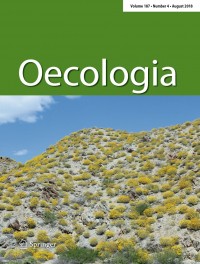Oecologia Q1 Unclaimed
Oecologia publishes innovative ecological research of general interest to a broad international audience. We publish several types of manuscripts in many areas of ecology.
Why publish with us?
We are one of the most highly cited journals in ecology, with 37,755 citations in 2021.
We welcome research from across the entire field of ecology, including the latest investigations in physiological ecology, conservation ecology, behavioral ecology, population and community ecology, plant-microbe-animal interactions, ecosystem ecology, global change ecology, and conservation ecology.
This journal welcomes contributions that support and advance the UN's sustainable development goals, in particular SDG 14 Life Below Water and SDG 15 Life on Land.
Our renowned team of Editors-in-Chief and highly regarded Editorial Board includes some of the world's leading voices in ecological research.
Our editorial board nominates the papers for the dedicated section of """"Highlighted Student Research"""". Each year, two awards are given to the outstanding papers by student authors.
No publication charges unless publishing open access. It has an SJR impact factor of 0,966.
Oecologia focuses its scope in these topics and keywords: habitat, plant, benefits, effects, importance, mediterranean, nutrient, pica, redistribution, reproduction, ...
Type: Journal
Type of Copyright:
Languages: English
Open Access Policy: Open Choice
Type of publications:
Publication frecuency: -
2690 €
Inmediate OANPD
Embargoed OA0 €
Non OAMetrics
0,966
SJR Impact factor227
H Index158
Total Docs (Last Year)658
Total Docs (3 years)10737
Total Refs1754
Total Cites (3 years)657
Citable Docs (3 years)2.33
Cites/Doc (2 years)67.96
Ref/DocOther journals with similar parameters
Fungal Diversity Q1
Genome Biology Q1
Annual Review of Ecology, Evolution, and Systematics Q1
Trends in Ecology and Evolution Q1
Annual Review of Entomology Q1
Compare this journals
Aims and Scope
Best articles by citations
An examination of a compensatory relationship between food limitation and predation in semi-domestic reindeer
View moreC 4 grasses in boreal fens: their occurrence in relation to microsite characteristics
View moreResponses of dispersal agents to tree and fruit traits in Virola calophylla (Myristicaceae): implications for selection
View moreEvidence for oxidative stress in sugar maple stands growing on acidic, nutrient imbalanced forest soils
View moreDominant cold desert plants do not partition warm season precipitation by event size
View moreSelection and migration in two distinct phenotypes of Littorina saxatilis in Sweden
View moreLeaf dynamics of a deciduous forest canopy: no response to elevated CO 2
View moreElevated CO 2 reduces sap flux in mature deciduous forest trees
View moreDominant meat ants affect only their specialist predator in an epigaeic arthropod community
View moreDoes flood tolerance explain tree species distribution in tropical seasonally flooded habitats?
View moreUncoupling of omnivore-mediated positive and negative effects on periphyton mats
View moreFine-root biomass and fluxes of soil carbon in young stands of paper birch and trembling aspen as affected by elevated atmospheric CO2 and tropospheric O3
View moreColony structure in a plant-ant: behavioural, chemical and genetic study of polydomy in Cataulacus mckeyi (Myrmicinae)
View moreHot rocks or no hot rocks: overnight retreat availability and selection by a diurnal lizard
View morePositive and negative effects of leaf shelters on herbivorous insects: linking multiple herbivore species on a willow
View moreTadpoles' responses to risk of fish introduction
View moreFreeze/thaw stress in Ceanothus of southern California chaparral
View moreEffects of density and predation on Scaphiopus couchi tadpoles in desert ponds
View moreSex-biased movement in the guppy ( Poecilia reticulata )
View moreFlowering phenology and compensation for herbivory in Ipomopsis aggregata
View moreSuperparasitism and sex ratio adjustment in a wasp parasitoid: results at variance with Local Mate Competition?
View moreIntraspecific litter diversity and nitrogen deposition affect nutrient dynamics and soil respiration
View moreSuccessful lizard eggs in a human-disturbed habitat
View moreWhy do melanin ornaments signal individual quality? Insights from metal element analysis of barn owl feathers
View more


Comments